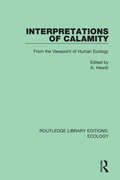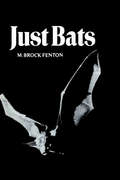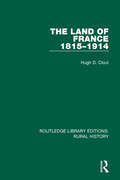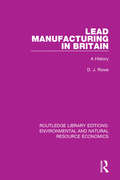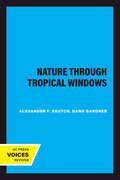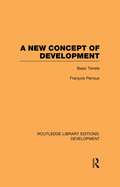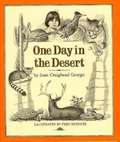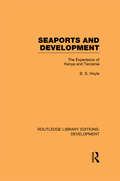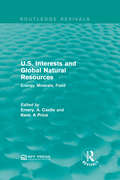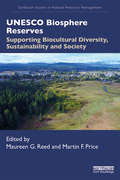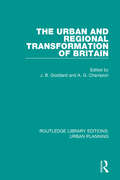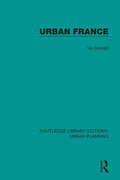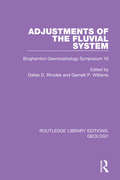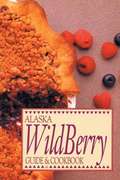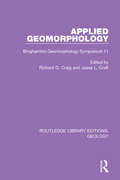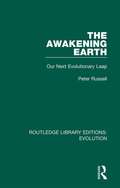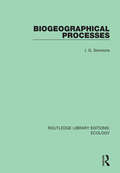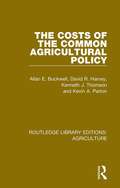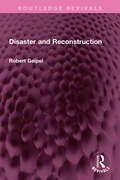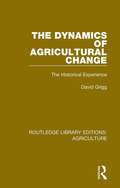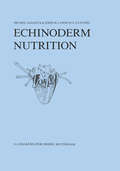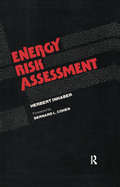- Table View
- List View
Interpretations of Calamity: From the Viewpoint of Human Ecology (Routledge Library Editions: Ecology #4)
by K. HewittOriginally published in 1983, Interpretations of Calamity provides a provocative critique of the ‘dominant view’ of research into natural hazards. Throughout the world, there are now many people professionally engaged in the mitigation and control of risks & hazards, and the impact of continuing economic development will ensure that they are fully employed. There is a wealth of perspectives in the book, including weather and wheat yields in the Soviet Union and Canada, an historical view of underdevelopment and hazards in Ireland and the impact of a response to drought in southern Africa, the Sahel and the Great Plains of the USA. The book reflects the major themes of hazards in the context of economic development and social change. Most of the case studies are from the rural and agriculture scene. This book provides a unique view of the vital importance of food production and of the considerable, and sometimes calamitous, impact that frost, flood, storm and drought have on the wellbeing of millions of people and on the stability of the international economic system.
Just Bats
by M. Brock FentonBats are dangerous to man. Right? Wrong. Here is the truth about chiroptera, the only mammals that fly, in a short, well-illustrated account based on solid research but intended for a general reader. Bats, of which there are about 850 species in the world, are maligned as carriers of rabies (largely untrue) and admired for their biosonar. Heir diversity is reflected in their diets: some eat fruit, some nectar and pollen, other fish, birds, frogs, or other bats. Although most eat insects, it is the three species of blood-feeding vampires which receive most public attention and around which much myth and superstition (and misconception) have evolved. In addition to their diet and habit, Fenton discusses their remarkable sonar sight, their reproduction, migration, patterns of behavior ? from hunting to mating ? parasites, enemies, and life span. (The current record is held by an Ontario Little Brown Bat which in 1980 had survived more than 30 years. ) Man?s attitude toward bats, his destruction of their habitats, and his use of pesticides have contributed to a sharp decline in the bat population in many parts of the world. Many biologists are becoming increasingly concerned about the survival of some species, but maintaining their numbers requires a change in people?s attitudes. Just Bats will help. It will also tell the reader how to evict bats from his attic ? provided he knows how they got in.
The Land of France 1815-1914 (Routledge Library Editions: Rural History #3)
by Hugh D. CloutThis book, first published in 1983, attempts to examine the rural change in France between 1815 and 1914 with a sustained and explicit spatial approach. This volume represents a position in which space and time are meshed in an analysis of the forces underlying land-use and other changes that have contributed much to the making of the French landscape. In this book the shift from the rural economy towards the urban markets in this period is examined thoroughly, using the vast statistical record of cadastral surveys and agricultural enquiries as well as contemporary reports and agricultural journals. The detailed mapping of historical data is a major feature of the treatment. As a scholarly account of a major topic in historical geography, The Land of France 1815-1914 should appear to all students and researchers with interests in historical and rural geography and economic history and especially those specialising in European studies.
Late- and Postglacial Oscillations of Glaciers: Glacial And Periglacial Forms
by H. Schroeder-LanzThis volume represents the proceedings from a colloquium held in West Germany in 1980 on late and postglacial oscillations of glaciers. The main texts are in German (13), English (8) and French (5) but all have abstracts in the three languages and all the figure captions are similarly translated.
Lead Manufacturing in Britain: A History (Routledge Library Editions: Environmental and Natural Resource Economics)
by D. J. RoweOriginally published in 1983. Extensive research into the archives of the lead industry has culminated in this comprehensive and fascinating account of the industry from the earliest times to the 1980’s. It traces the origins of the various types of lead manufacturing and the nineteenth-century expansion of the industry. The technological changes within the industry are traced in detail, and an appraisal of modern industry and its future prospects concluded this definitive and very readable history of the lead industry.
Nature through Tropical Windows
by Alexander F. SkutchThis title is part of UC Press's Voices Revived program, which commemorates University of California Press’s mission to seek out and cultivate the brightest minds and give them voice, reach, and impact. Drawing on a backlist dating to 1893, Voices Revived makes high-quality, peer-reviewed scholarship accessible once again using print-on-demand technology. This title was originally published in 1983.
A New Concept of Development: Basic Tenets (Routledge Library Editions: Development)
by François PerrouxFirst published in 1983, François Perroux’s A New Concept of Development analyses the major paradox of our era: the desire for progress and the mistrust of its consequences. The authors argues that the approach to the question of development may be the key to understanding both the present and what the future brings, representing a pattern which will seek to shape man’s potential to his designs. By analysing the ideas and theories propounded by the economic approach the author’s aim is to clarify both the meaning and direction of research in development. A scientific, oriented economy and efficient strategies should and must be the two components of one and the same momentum, required to go beyond the perilous paradox of our era.
One Day in the Desert
by Jean Craighead GeorgeExplains how the animal and human inhabitants of the Sonoran Desert of Arizona, including a mountain lion, a roadrunner, a coyote, a tortoise, and members of the Papago Indian tribe, adapt to and survive the desert's merciless heat.
Seaports and Development: The Experience of Kenya and Tanzania (Routledge Library Editions: Development #69)
by B. S. HoyleThis book, originally published in 1983, demonstrates the importance of seaports in the growth of less-developed countries. The author focuses on the character of port activity within the context of transport systems and regional economic planning. General principles of port development are illustrated by detailed reference to one Third World port group, that of the Indian Ocean coasts of Kenya and Tanzania. The objective is not merely to illustrate the character of one specific group of ports, but to demonstrate methods of analysis and to underline the crucial role of ports in the development process.
The Story of the San Francisco Earthquake (Cornerstones of Freedom)
by R. Conrad SteinDescribes the devastating earthquake and ensuing fire that destroyed much of San Francisco in the spring of 1906.
The Talking Earth
by Jean Craighead GeorgeBillie Wind ventures out alone into the Florida Everglades to test the legends of her Indian ancestors and learns the importance of listening to the earth's vital messages.
U.S. Interests and Global Natural Resources: Energy, Minerals, Food (Routledge Revivals)
by Emery N. Castle Kent A. PriceOriginally published in 1983, U.S. Interests and Global Natural Resources explores the links between foreign policy and the global distribution of natural resources paying particular attention to the U.S. This collection of essays delves into the importance of factors such as differing economic development and political hostility could have on the provision of resources into the U.S and advises that nations identify their countries needs and establish policies to safeguard them. This title will be of interest to students of Environmental Studies and Policy makers.
UNESCO Biosphere Reserves: Supporting Biocultural Diversity, Sustainability and Society (Earthscan Studies in Natural Resource Management)
by Maureen G. Reed Martin F. PriceUNESCO Biosphere Reserves (BRs) are designated areas in geographical regions of global socio-ecological significance. This definitive book shows their global relevance and contribution to environmental protection, biocultural diversity and education. Initiated in the 1970s as part of UNESCO’s Man and Biosphere (MAB) Programme, BRs share a set of common objectives, to support and demonstrate a balance between biodiversity conservation, sustainable development and research. The world’s 701 BRs form an international, intergovernmental network to support the aims of sustainability science, but this purpose has not always been widely understood. In three distinct sections, the book starts by outlining the origins of BRs and the MAB Programme, showing how they contribute to advancing sustainable development. The second section documents the evolution of BRs around the world, including case studies from each of the five UNESCO world regions. Each case study demonstrates how conservation, sustainable development and the role of scientific research have been interpreted locally. The book concludes by discussing thematic lessons to help understand the challenges and opportunities associated with sustainability science, providing a unique platform from which lessons can be learned. This includes how concepts become actions on the ground and how ideas can be taken up across sites at differing scales. This book will be of great interest to professionals engaged in conservation and sustainable development, NGOs, policy-makers and advanced students in environmental management, ecology, sustainability science, environmental anthropology and geography.
The Urban and Regional Transformation of Britain (Routledge Library Editions: Urban Planning #12)
by J. B. Goddard and A. G. ChampionOriginally published in 1983 The Urban and Regional Transformation of Britain, analyses economic and social changes recorded across the cities and regions of Britain since the Barlow Report. The collection analyses the whole country at a more detailed scale than the ten Standard Regions, for which most official statistics are produced. Although there are important differences between the major regions of Britain, many of the recent processes of change appear to have operated at a local level within rather than between regions. The essays in this volume bring together change at the regional and local labour market scales and provides a comprehensive statement of urban and regional change, seeking to highlight the new spatial priorities of the 1980s.
Urban France (Routledge Library Editions: Urban Planning #19)
by Ian ScargillOriginally published in 1983, Urban France examines the rapid growth in French cities between 1950-1980, and the serious consequences that have followed this rapid growth. This volume examines the nature of this urban explosion and the efforts of planners and others to find solutions to the resultant problems of the post-war period. The book addresses the debates surrounding the urban system, urban planning, housing and land use, retailing, and the inception of new towns.
Adjustments of the Fluvial System: Binghamton Geomorphology Symposium 10 (Routledge Library Editions: Geology #1)
by Dallas D. Rhodes and Garnett P. WilliamsThis book, first published in 1979, collects together a key set of papers from the 10th Binghamton Geomorphology Symposium. They analyse fluvial theory, channel processes, stream adjustments, paleo-adjustments and channel adjustments.
Alaska Wild Berry Guide And Cookbook
by Editors of Alaska MagazineA discription of and recipes for nearly 50 wild berries that grow in Alaska.
Applied Geomorphology: Binghamton Geomorphology Symposium 11 (Routledge Library Editions: Geology #3)
by Richard G. Craig and Jesse L. CraftThis book, first published in 1982, forms the proceedings volume of the 11th Binghamton Geomorphology Symposium. Chapters cover various coastline phenomena, glacial and periglacial processes, carbonate terrains, and specific applications of geomorphic knowledge and techniques.
The Awakening Earth: Our Next Evolutionary Leap (Routledge Library Editions: Evolution #11)
by Peter RussellOriginally published in 1982 The Awakening Earth explores the idea of the Earth as a collective, self-regulatory living organism, and considers in this context, the function of the human race. The book provides an exploration of humanity’s potential and explores the possibility of mankind’s evolutionary future. Drawing on the work of physicists, psychologists, philosophers and mystics, the book argues that humanity is on the verge of another evolutionary leap and explores evolution in the context of spiritual growth, arguing that widespread inner awakenings could lead to a more analogous society, functioning as a single social super-organism, much in the way cells in a body function as a biological organism.
Biogeographical Processes (Routledge Library Editions: Ecology #11)
by I. G. SimmonsOriginally published in 1982, Biogeographical Processes is a concise introduction to biogeography aimed at undergraduate students. It provides a detailed overview of man and his environment and includes data from such research projects as that of the International Biological Programme. The book argues that natural processes can be viewed as a datum line to which the human impact through time is added. It suggests that through this datum line, the man and the biological environment are inextricably linked. The book firstly examines the fundamental processes determining the distribution of plants and animals, and the interactions between such processes leading to the concept of the ecosystem. The book also examines major world ecosystems, or biomes, such as forests, grasslands and oceans as if they were in a natural condition and discusses the affect of human impact upon such systems. The book also discusses the alternative future relationships of man and other living organisms. Although over 30 years old, the book still contains a useful and detailed overview of biogeography. It will be of interest to students or lecturers in ecology, biology and the environmental sciences.
The Costs of the Common Agricultural Policy (Routledge Library Editions: Agriculture #7)
by Allan E. Buckwell David R. Harvey Kenneth J. Thomson Kevin A. PartonFirst published in 1982. Considerable public controversy surrounded the large amount of public expenditure devoted to agriculture under the European Community’s Common Agricultural Policy (CAP). There were serious disputes over how the farm support system operated and how it was financed. This book describes the CAP situation and summarises previous attempts to assess some of the economic and financial flows arising from its creation using a common framework of well-established economic theory and methods. The CAP turned out to have a number of ‘costs’, depending on the concept of ‘cost’ used, the alternative policies considered, and the various assumptions made. The bulk of the book presents the structure and results of a comprehensive model of European Community agricultural markets and the associated CAP support mechanisms. This model is validated against official Community budget figures and then run to simulate a number of policy options and their consequences. This title will be of interest to students of economics, geography and agriculture.
Disaster and Reconstruction (Routledge Revivals)
by R GeipelOriginally published in 1982 and based on empirical research into the aftermath of the Friuli earthquake in Italy, the book reflects the perspective gained over a period of four years on the event itself and the subsequent response of the local population and national government. Unique insights were gained through one of the largest questionnaire surveys ever undertaken in a disaster situation and important questions are posed concerning the policies of reconstruction. Is a disaster ‘the great equalizer’ and does regional society emerge from it with redistributed power relationships, or are established structures reinforced? Who gets hurt and who benefits? What effects do poverty, regional remoteness from central government and the ethnic and cultural dimensions have on the situation? As a substantial treatment of a major catastrophe in all its aspects, this book will be of interest to students and researchers concerned with the impact of and response to natural hazards. It is based on a unique event, but the findings it reveals are relevant to all major catastrophes.
The Dynamics of Agricultural Change: The Historical Experience (Routledge Library Editions: Agriculture #10)
by David GriggFirst published in 1982. Until the nineteenth-century the history of agriculture was the history of mankind but it has not perhaps received the wide attention that this importance justifies. In this study, the author reviews for the student of agricultural history successive attempts to describe and explain agricultural changes that are not specific to a limited area or a particular time. In a sense The Dynamics of Agricultural Change is a systematic historical geography of agriculture. Some of the models the author explores have been developed within agricultural history; some, drawn from other disciplines, can be applied fruitfully to it. What is the relationship between population growth and agricultural development? Between environmental changes and those in agriculture? What was the effect of the industrial revolution? And has there been an agricultural revolution? This book suggests to university students of economic history, historical geography and agriculture, a number of stimulating ways of interpreting and reinterpreting agricultural history.
Echinoderm Nutrition
by Michel Jangoux John M. LawrenceThe purpose of this book is to present the state of knowledge concerning nutrition and point out directions for future work for the Echinodermata, an ancient group which shows great diversity in form and function, and whose feeding activities can have great environmental impact.
Energy Risk Assessment
by Herbert InhaberFirst Published in 1982. Comprehensive and controversial, this book presents an overview of the energy options available and their attendant risks. The entire energy cycle- from raw material to final energy production- is examined in depth so that accurate and detailed assessments can be made of the risks of energy options.
